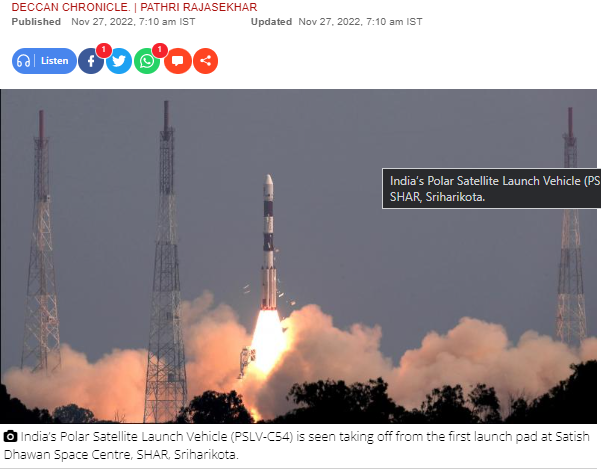
Nellore: The workhorse Polar Satellite Launch Vehicle (PSLV-C54) once again proved its reliability on Saturday, placing the Earth Observation Satellite (EOS-06) and eight nanosatellites in two different orbits in space on Saturday.
The rocket, in its XL version, took off from the first launch pad at Satish Dhawan Space Centre, Sriharikota, on schedule at 11.56 am. It injected the EOS-06 into a sun-synchronous polar orbit 17 minutes after the launch.
Scientists then moved the rocket to a lower orbit where it placed eight small satellites in orbit, after one-and-a-half hours.
Dr S. Somanath, chairman of the Indian Space Research Organisation (Isro), announced that the mission was successful and congratulations, led by Prime Minister Narendra Modi, started pouring in soon.
Dr Somanath said the solar panels and antennas of both EOS-06 and another spacecraft, the India-BhutanSat (INS2B), were deployed.
The INS-2B is Isro’s second nanosatellite launch for Bhutan. Bhutanese information minister Lyonpo Karma Donnen Wangdi was all praise for Isro after witnessing the launch from the mission control room. He said that the mission is another key milestone of the close relationship between India and Bhutan.
Meanwhile, external affairs minister Dr S. Jaishankar said that Isro was working on setting up a ground station in Bhutan.
Besides the EOS-06 and INA2B, four nanosatellites of Spaceflight USA, one from Swiss communication company Astrocast and two of Hyderabad-based Dhruva Space, named Thybolt 1 and Thybolt 2, were launched.
The ninth was a nanosatellite named ‘Anand’, the third hyperspectral satellite developed by space tech start-up Pixxel.
With Saturday’s launches, the PSLV has placed 349 foreign satellites in orbit, while LVM3 placed 36.
The 1,117-kg EOS-6 satellite, with a five-year mission life, was the third-generation satellite in the Oceansat series, designed at ensuring data continuity of ocean colour and wind vector data to sustain operational applications.
Additional datasets, such as sea surface temperature and more bands in the optical region for fluorescence and in the infrared region for atmospheric corrections, were accommodated in the satellite.







